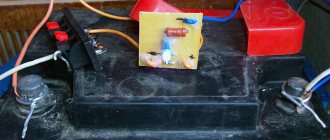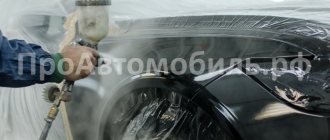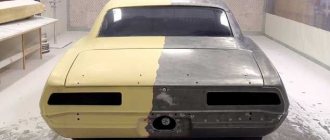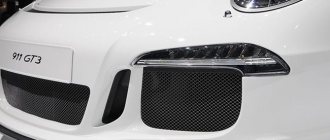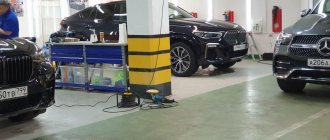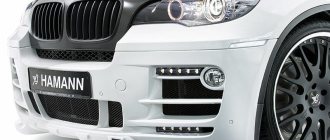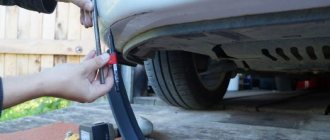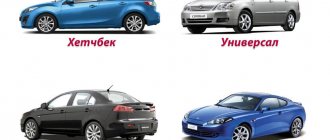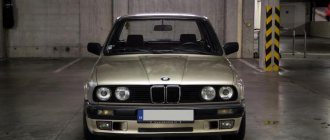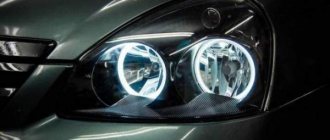External coating techniques represent the most extensive group of methods for anti-corrosion protection of metal. Priming is often used to protect automobile bodies that are exposed to various types of influences that contribute to the development of rust. One of the most effective methods of such protection is cataphoretic coating, which simultaneously combines elements of physical and chemical insulation.
Preparation of technological equipment
The technical basis for performing the cataphoresis treatment procedure is the limiters for body elements, including the hood, trunk and side doors. All these parts must be slightly open so that the active mixture freely fills the cavities from the inside, leaving no gaps. From the point of view of in-line production, the solution for cataphoresis coating is thus saved on the line, since the unused composition is completely drained into a special container and used in subsequent operations. The function of drain channels is usually performed by holes in the bottom of the car body. You should also ensure that they are open in advance.
Cataphoresis treatment of the new body
Cataphoretic priming is used in a wide variety of industries. Processing car bodies in this way is also very common. This technology has been used abroad for quite some time. It came to us several years ago and is successfully used in the production of domestic cars.
Priming a new body using electrolytic cataphoresis is much cheaper than galvanizing, so this technology has every chance of further development in the automotive industry. In addition, as mentioned above, metal protection from corrosion is at a very high level, which is an order of magnitude higher than galvanizing.
The cataphoresis priming procedure is approximately the same as described above. When manufacturing a new car, the body goes through all stages of cataphoresis, from removing metal oxide to drying in thermal chambers.
Washing body surfaces
The next stage of preparation is pre-washing. All foreign particles from dirt and dust to welding products and factory lubricants should be removed not only from the external surfaces, but also from the interior of the body. On professional lines for such purposes, chambers with many nozzles are used that direct water with a cleaning solution. A simpler option involves the use of mini high-pressure washers with the connection of compressor units. In any case, the better the initial cleaning, the greater the chances of obtaining a stable and durable protective coating for the car body with an emphasis on the formation of an anti-corrosion barrier.
What conclusion can be drawn, knowing the differences in car painting technology at a factory and a service station?
If your car has been damaged in an accident and body repairs are required, you can choose several options: 1.
You can sell the car (as is) without doing anything to it.
No one will do it for you just like at the factory. And the repairs will soon be visible. Therefore, without bothering with buying spare parts, searching for good craftsmen, just sell your car. Resellers who deal in damaged cars will be happy to buy your damaged car from you. 2.
You can find a modern service station and have your car expensively repaired by painting it in an ultra-modern chamber.
Then drive the car for a while and sell it before corrosion ruins its appearance. Now you know that 2-3 years will pass and all the repairs will come out.
3.
You can find Uncle Zhora, who, according to reviews, does car painting well and inexpensively.
Paint the car from him and sell it while it is still in marketable condition. Or drive until there is through corrosion, and then go back to Uncle Zhora and paint the car again. In any case, the choice is up to you.
If you nevertheless decide to repair (paint) the car and find a painter, Uncle Zhora, then in order to avoid being charged extra money for non-existent material for painting a car, it is advisable for you to have a general understanding of the technology of painting a car during repairs.
Degreasing surfaces
The presence of traces of technical oil or other chemicals on body surfaces can lead to the preservation of open areas, which often become hotbeds for the development of rust after damage. Therefore, it is very important to carry out the degreasing operation. Usually, before applying cataphoresis coating, this problem is solved by spraying. The car passes through a special tunnel, where it is also supplied with high-pressure water, but with the addition of special chemicals. The method of immersion in baths with degreasing solutions is also practiced, but this approach is justified only in the conditions of a high-performance car service with a large flow.
Cataphoresis for body repair
Before applying paint and varnish materials, the body goes through the following stages:
- the vehicle is completely disassembled, as all parts undergo individual processing;
- old paint is removed by immersing the body in specialized chemicals;
- an outdated car has signs of corrosion that can be eliminated using specialized anti-rust products;
- The body, cleaned to bare metal, is ready for cataphoresis, which is carried out according to the rules described above.
How to degrease metal?
So, what additives are used after complex rinsing before applying the cataphoretic composition? The simplest and most accessible material is alkaline solutions. These are useful active components that, together with degreasing enhancers, provide a good cleaning effect and basic protection. If there is a high degree of fat concentration, you will have to use specialized products. For example, how to degrease metal if the surface grease exceeds 3 g/m2? In this case, you can use specialized auto chemicals from the companies Henkel, Chemetall or EKOCHIM, made on the basis of solid and chlorinated particles of polyvinyl chloride and acrylonitrile butadiene styrene. As practice shows, the key factor in the effectiveness of a degreasing solution will not be so much its concentration as the correctly selected temperature conditions during processing.
Lada models with galvanized body
There is no exact information about how many parts are galvanized, and AvtoVAZ does not disclose them. Various indicators are mentioned, but there is no official confirmation of them. According to media reports, Lada cars have the following degree of galvanization:
- VAZ-2110: 30%;
- Niva 2131/2121, Lada 4x4: no galvanized steel, cataphoretic priming;
- Kalina (first generation): 52%;
- Kalina (second generation): fully galvanized, except for the hood, roof, rear/front side members;
- Priora: models from 08.2008 – galvanized 29%, from 2009 – 100%;
- Largus: there are galvanized parts, which ones are unknown;
- Vesta: the outer body layer is completely galvanized (sedan - with a non-galvanized roof, station wagon - fully galvanized), the bottom and sills are with anti-gravel protection;
- Xray: external body elements are completely galvanized, with the exception of the roof.
Activation and phosphating of surfaces
The transitional stage between cleaning the target surface and creating a base for cataphoretic coating is phosphating. In turn, the activation of the metal will act as a preparatory operation, which is carried out in order to improve crystal formation in the bath. For this purpose, insoluble compounds, manganese phosphate and titanium salts are used. They provide a settling effect on the surface, helping to compact the phosphate layer.
Activation forms the basis of the protective coating of the car body, promoting adhesion. After phosphating, the coating is monitored, during which properties such as total acidity, density, weight, etc. are assessed. The composition of the solution can also be analyzed. The standard set of components is formed by zinc elements, fluorides and additional modifying additives, which are selected individually.
Painting a car at the factory
Cars are painted not only for beauty. The main task of painting a car is to protect the body from corrosion. Corrosion is the main enemy of a car. Service stations do not have the ability to protect the car body from corrosion in the same way as they do in car production.
Currently, factories producing cars mostly use galvanizing and cataphoresis as the main methods of protecting car bodies from corrosion. It is believed that galvanizing the metal of the car is more reliable, but much more expensive (affects the cost of the car).
Galvanization protects machine parts from through corrosion, depending on the thickness of the coating, from 15 years and above. Galvanization is used on cars such as Porsche, Audi, Volvo, BMW, Mercedes. Concerns such as Toyota, Honda and others use galvanization of body metal.
Cataphoretic coating
A cheaper and less effective way to protect a car body from corrosion is cataphoresis coating. For example, cataphoresis coating is applied to VAZ cars.
But even relatively cheap body protection, such as cataphoresis, has complex technology. Briefly, it looks like this: to apply a protective coating that protects the metal of the body from corrosion, the car goes through several stages before painting. First, the bare metal after welding is cleaned of the oxidizing film (the metal instantly oxidizes in air), then the metal is degreased and coated with a phosphate film. And then a cataphoresis coating is applied to the car body. This protective coating can be applied to the metal body only in the factory. There are no such technologies at service stations!
How is protection formed?
Reliable protection of the body metal from corrosion is formed as a result of electrodeposition of soil in a special bath. At the factory there is a huge bathtub filled with diluted automotive soil, to which an electric wire (anode) is connected, through which a current with a “+” sign flows.
The entire car body is lowered into this bath. Another electrical wire (cathode) is connected to the car body, through which electric current flows with a “-” sign. Under the influence of an electric field, soil particles are introduced onto the metal surface of the car.
A strong film of soil is formed, which penetrates into all pores of the metal. The soil seems to eat into the metal and evenly cover the entire surface of the car part. This film is a reliable protection of the body metal from corrosion. And only after this the car body is primed for painting.
Then the primer is dried and the car is painted in the desired color. Can you imagine how complicated the process is?
I described the cataphoresis process in such detail so that you understand that at service stations (where cars are repaired and painted), in principle, they cannot reproduce this complex electrochemical process of protecting the metal of a car from corrosion. This means that corrosion will come out some time after the body repair.
What is cataphoretic primer?
The main component of the coating is a lead-free two-component mass, which can be presented in the form of a paste or emulsion. In the newest generations, such primers are characterized by environmental safety and high penetrating ability. With the help of modifiers, thermal resistance and protection from corrosive processes are also improved. In addition, during operation, rust removal improves without damaging the body base. Emulsions containing several cationic polymers are used directly during cataphoresis. The formed layer is an elastic film with blocked isocyanate. The composition may also include a pigment paste based on mineral components, binding active substances and demineralized liquid.
Cataphoresis for body repair
Before applying paint and varnish materials, the body goes through the following stages:
- the vehicle is completely disassembled, as all parts undergo individual processing;
- old paint is removed by immersing the body in specialized chemicals;
- an outdated car has signs of corrosion that can be eliminated using specialized anti-rust products;
- The body, cleaned to bare metal, is ready for cataphoresis, which is carried out according to the rules described above.
Cataphoretic priming is given special attention, since the technique is still young and unstudied. However, its demand is growing, which stimulates the development of the industry and the improvement of the quality of car body protection.
Application of primer
The protective structure is formed in a bath into which an emulsion with a paste containing the necessary additives has been previously loaded. The average volume of a bath for the cataphoresis method of corrosion protection is 100 m3 per body. Simultaneous processing of several vehicles is also allowed. In this case, containers of 200-300 m3 are used.
Dialysis cells with metal cathode rods are connected to the bath along the perimeter. This is an important part of the technology that, in principle, provides electrochemical action. When voltage is applied, the cataphoretic soil is charged, followed by the formation of a protective layer up to 25-30 microns thick. As for the charging parameters, the current should be from 350 to 700 A with an average voltage of 400 V. The operation lasts 2-3 minutes.
Factory primer of new car body panels
New car body parts, in most cases, have a black coating. This is factory soil. If the body panel is original (OEM) or from a certified manufacturer, then it is covered with the so-called cataphoretic primer, applied by electrodeposition.
At the factory, the part goes through several stages of processing. First, it is degreased, phosphated, then covered with primer using electrodeposition in a special tank. As a result, phosphate and polymer protective films are formed.
After application, at a temperature of 150 to 200 degrees Celsius. Because of this, it completely polymerizes and becomes more durable and chemically inert.
The composition of cataphoretic primer is in most cases epoxy and is a good protective anti-corrosion coating.
Cheaper body parts may have shipping primer, which is not a durable protective coating and must be removed.
The cataphoretic primer on the surface of the body panel has a very thin layer. It has the following advantages:
- Has a strong bond with the metal surface.
- The soil layer produced in the factory by electrodeposition is very smooth and uniform (everywhere has the same thickness) over the entire surface.
- The entire part is covered with primer, including hidden cavities.
- The coating does not contain any unnecessary impurities.
- Has anti-corrosion and adhesive properties.
Drying metal surfaces
Unlike other fast drying technologies, in this case the polymerization process also has the character of a mild thermal effect with burning. For this operation, special ovens are used that allow several stages of drying. At each stage, a corresponding module with an independent burner (usually gas fuel) is connected, heating the air to the desired temperature. Heat flows in the direction of the body are supplied by fan units. Moreover, each thermal effect circuit contains filters that clean the air from the smallest particles that can harm the structure of the coating. With regard to the choice of temperature conditions, much depends on the characteristics of a particular metal. For automotive body structures, corrosion protection is secured under polymerization conditions at 180-200 °C. Moreover, for each individual part the temperature can vary due to special sensors. A special approach is usually used for the roof, dashboard and underbody.
Transport soil: to remove or not?
If the painter doesn't care what the part is primed with, then the results of painting will be as predictable as the results of a game of Russian roulette.
Gray and black
If a car is thoroughly damaged by life, the question inevitably arises of replacing body parts: fenders, doors, sills, panels. And we go to buy new spare parts - usually to the market.
Most new body parts are shipped with a primer coat already applied.
Benefits of technology
Among the main advantages of this technique is the high resistance of the soil to external negative influences, which create conditions for the formation of corrosion. Having carried out rust removal at the first stage with abrasives of the required fraction, in the future you can forget about the risks of such damage from high humidity and salt influences. In this case, cataphoresis is used not only as a technological protective coating, but also as a decorative one, if the primer solution is combined with powder paint. Other advantages of this method include high processing speed, uniform laying of the layer, high penetrating ability and the already mentioned environmental safety.
Cataphoretic priming of body parts
New body parts also began to undergo cataphoretic priming at the stage of their manufacture. However, today this only applies to original parts. Cheap analogues from other manufacturers cannot be fully processed using this method. Basically, new parts are covered with a transport primer, which protects the part during the stages of transportation and storage until the moment of sale.
Today, cataphoresis priming of body parts before painting is quite often practiced. To do this, the part is handed over to a company that has equipment for cataphoresis. There it is cleared of transport soil and processed using the technology described above. This allows you to significantly increase the service life of even non-original parts.
Alternative methods of anti-corrosion protection
The closest technology of anti-corrosion protection, which in principle can be compared with cataphoresis, is anaphoresis. It is also a type of electrolytic dyeing, but with some differences. In particular, the anaphoresis method of corrosion protection involves a negative charge of the priming solution, and the target surface is associated with a positive circuit. From the point of view of the quality of the coating device, this is not of fundamental importance, but organizational processes are facilitated due to the elimination of the mandatory grounding device for the bath and the supply of dialysis cells. In addition, the requirements for paint deposition and drying procedures are reduced.
Shot blast chamber
The shot blasting chamber is designed for mechanical cleaning of parts before further surface preparation. The shot blast chamber consists of the following components:
- The shot processing chamber is made entirely of abrasion-resistant sheets and plates, equipped with a service door;
- entrance and exit gateways with rubber curtains;
- abrasive collection hopper;
- screw conveyor for collecting waste abrasive;
- bucket elevator;
- abrasive air separator;
- storage bunker;
- screw conveyor for large contamination;
- trash container;
- distribution transverse screw conveyor (for distributing abrasive between shot blast turbines);
- six abrasive supply control devices;
- six wear-resistant shot blast turbines;
- brush-blowing unit;
- cartridge dust collector;
- part availability recorder;
- automation cabinet.
The total consumed electrical power of the shot blasting machine is 171 kW.
Section for loading side members onto the suspension
The loading section is designed for automatic hanging of side members and reinforcements onto the PTK suspension. The site consists of the main elements:
- Roller table section;
- Cross conveyor with a lifting mechanism (for removal from the roller table and longitudinal movement of the side members);
- Automatic mechanism for hanging side members and reinforcements onto the suspension (8 pcs. per suspension);
- Mechanism for moving paint equipment from the side members unloading area to the side members loading area;
- Storage for painting equipment.
The automatic curtain section is a platform with a mechanism for feeding spars and reinforcements into the curtain zone in the transverse direction. Painting equipment arrives to the site automatically and takes up its working position. The hydraulic scissor lift lifts at a fixed pitch. The painting equipment is equipped with hooks that engage the spar that has arrived along the transverse conveyor and lift it. The following hooks already engage the next spar, the next one at an equal distance. Then the operation is repeated until all the painting equipment is filled.
The painting equipment can accommodate 8 long products.
After the painting equipment is filled, the platform with the painting equipment and long products rises even higher and takes the “curtain” position. In this position, the painting equipment engages with the conveyor crossbar, which is in the “waiting” position. After the coating has taken place, the platform is lowered to the “loading the side members” position and the operator installs the elements of the painting equipment into special grooves.
Overhead push conveyor - designed to automatically move the suspension with the product along the technological stages of the line.
The conveyor consists of:
- profile rail line with a roller chain moving inside;
- a profile rail line with roller trolleys moving inside, on which the suspension with the product is located;
- grippers located at a certain pitch along the entire length of the conveyor chain;
- racks fixing the overhead conveyor;
- automatic “arrows” with a pneumatic drive (designed to move rollers from one conveyor line to another);
- electric motors driving the conveyor chain;
- conveyor chain tensioners;
- electric elevators in places of lifting from the first tier to the second and lowering from the second tier to the first. Elevators carry out vertical movements between sections of the conveyor rail together with roller trolleys and a suspension with products installed on them. One elevator moves two trolleys with one suspension installed on them. The elevator is equipped with a drive for pushing the traverse with products into the working position of the elevator;
- automatic stoppers that stop the suspension with products in a given place. The stop is carried out due to the mechanical action of the stopper on the leading suspension trolley, breaking its contact with the pusher of the conveyor driving chain. The stoppers operate automatically to prevent or resume suspension movement. Stoppers are installed in all sections of the conveyor and exercise full control over the movement of the suspensions, prevent their collision and delay them in the necessary technological areas;
- straight double section of the conveyor, with automatic stoppers, for the accumulation of suspensions;
- centralized lubrication system for chains and conveyor trolls;
- frequency converters to regulate the speed of the circuit.
| Conveyor specifications | |
| Nominal conveyor speed | 2.50 m/min. |
| Conveyor length | 1150 m. |
| Curtain pitch | 15.00 m. |
| Number of curtains | 76 pcs. |
| Maximum chain load | 190,000 kg. |
| Number of conveyor drives | 20 pcs. |
| Thermal expansion compensators | 4 things. |
| Maximum chain breaking load | 10,000 kg. |
| Time for the product to pass through the line in nominal mode | 8.7 hours |
| Time it takes for the product to move from the last drive to the end of the line in nominal mode | 1.7 hours |
| The interval between the exit of finished pendants from the line in nominal mode | 6.0 min. |
Cataphoretic coating: description of the technology and its advantages. Corrosion protection methods
External coating techniques represent the most extensive group of methods for anti-corrosion protection of metal. Priming is often used to protect automobile bodies that are exposed to various types of influences that contribute to the development of rust. One of the most effective methods of such protection is cataphoretic coating, which simultaneously combines elements of physical and chemical insulation.
Paint layers
To understand the purpose of the primer, it is important to consider the composition of the car's paintwork. After all, the essence of painting with your own hands is to get as close as possible to the factory coating
The following types of coatings are applied to each new metal part:
- primary primer (phosphate or cataphoresis). Used as the first stage of anti-corrosion protection of the body;
- secondary soil (filler). Serves as a leveling layer and damping pad for subsequent painting stages;
- dye. Thanks to pigments, it gives color to the details. Has no protective functions;
- varnish Serves as an additional protective layer for the body, adding depth and shine to the color.
Now let's take a closer look at the types of materials that can be used to protect thresholds and treat the bottom.
About the components
Based on the type of composition, there are two main types of primers:
- one-component;
- two-component.
An additional component that distinguishes these types is a hardener. Single-component materials take a very long time to dry, so they are practically not used now. If you buy an aerosol to treat, for example, thresholds, it will always be a two-component primer. Materials applied with a spray gun will need to be diluted before painting. The proportions of use of solvent and hardener are regulated by the instructions.
Primary primers
The technology of cataphoretic body treatment is a complex chemical process. There is no point in trying to repeat this type of factory processing with your own hands. That is why we will start with phosphating soils. The composition of such materials includes phosphoric acid, inclusions of zinc or lead chromates and phosphates, which, when reacting with the metal, form a layer of sparingly soluble phosphates.
Application
A feature of all primary coatings is the small layer thickness. About 8-12 microns, which is the smallest indicator among all paintwork layers. That is why this type of coating will not hide scratches filled with abrasive or pores after cleaning areas of corrosion.
Acid primer should be applied to “bare” metal, former areas of corrosion. Since the residual layer is very thin, it should not be sanded under any circumstances (it is very easy to wipe off). You will immediately erase the protective coating. That is why reactive soils are always additionally coated with filler.
Putty should not be applied to the primary coating. Debinzenol peroxide, which serves as a hardener for most putties, reacts with the phosphating coating, as a result of which all the strength of the chemical composition is lost. An epoxy primer applied over the etching primer will have a similar effect.
For local body repairs, it is better to choose an aerosol. If you bought primary primer in a can from an unverified manufacturer, it is better to test it before painting. Since it is possible to “undermine” subsequent layers due to the incompatibility of individual components. Drying time is about 10-20 minutes.
It is advisable to use phosphating primers when combating rusting of thresholds and painting unprotected metal of the bottom.
Epoxy type primers
Epoxy primer can be used if the car body does not have areas of corrosion. For large repair areas (for example, the underbody), we do not recommend using aerosol from unverified manufacturers. Often the quality of such materials does not meet standards. As a result, do-it-yourself anti-corrosion treatment of thresholds will not bring the expected effect.
The aerosol and the material for the spray gun from a famous brand will be made on the same basis. If further painting of the body with your own hands is carried out using materials of the same brand, you are guaranteed not to have problems with adhesion or compatibility of components.
The universal two-component epoxy primer has one undeniable advantage - hydrophobicity. It forms a denser protective layer than the same etching primer, which prevents moisture from penetrating the metal. Also, you will not have problems if you plan to putty the repair area. Epoxy primers are also insulating, so they can be applied in areas where old paint layers have been sanded. Old putty will not be contoured later. Excellent for thresholds if digestion was carried out with the installation of body repair kits.
